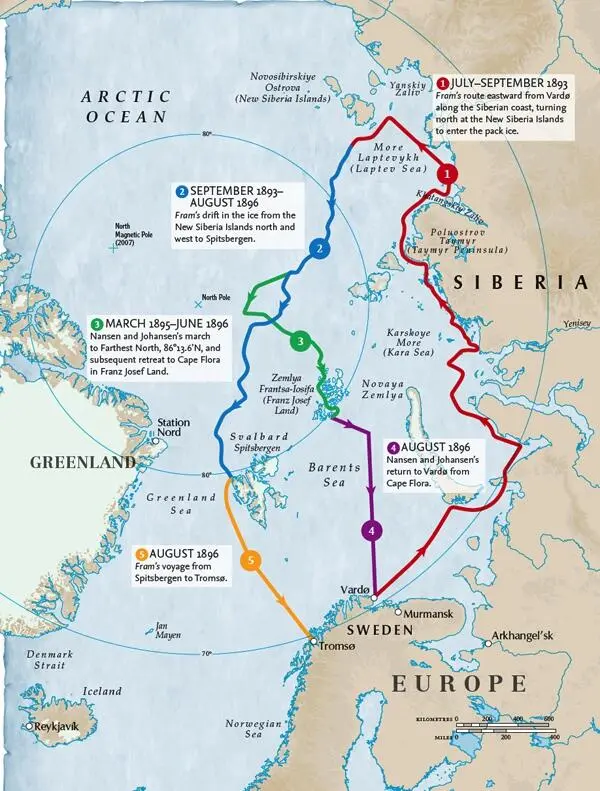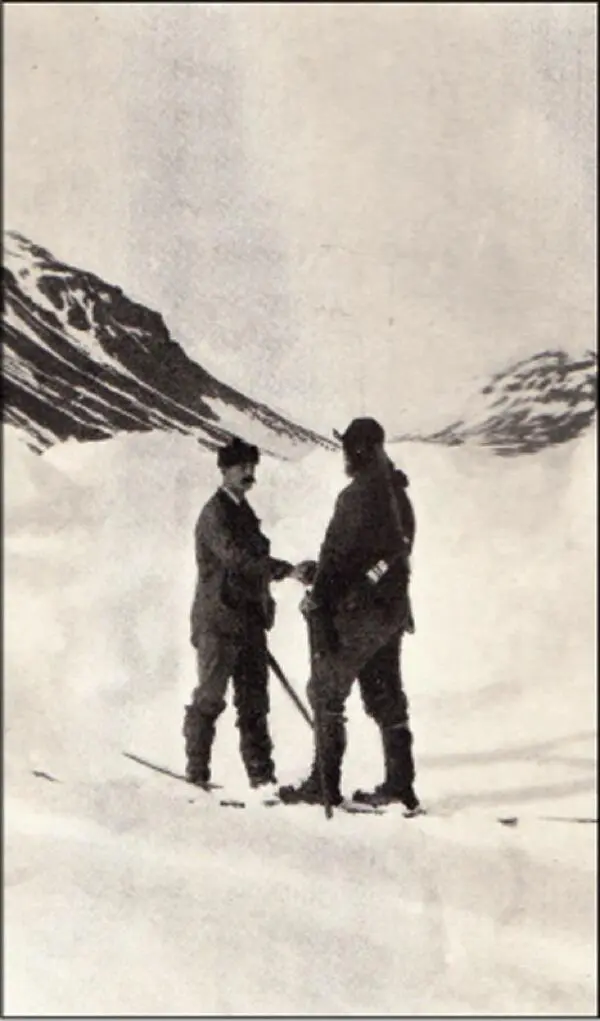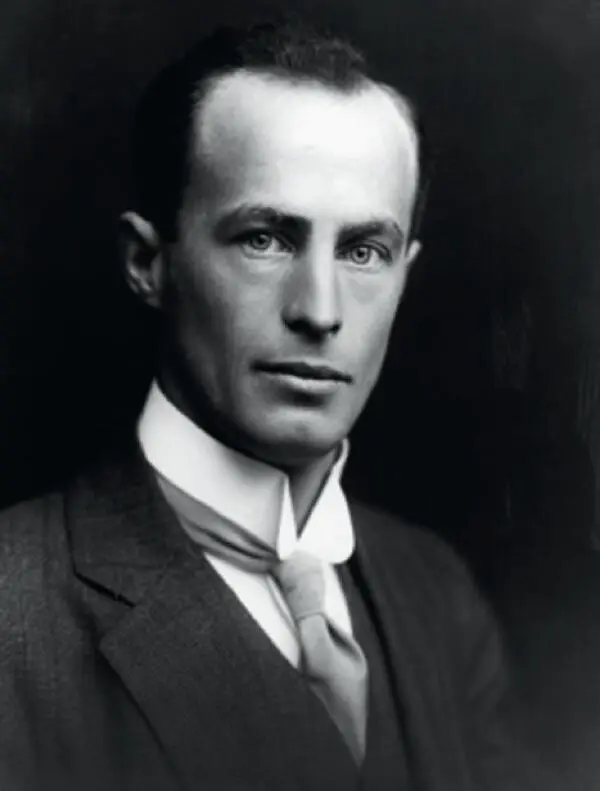It would be two and a half years before they were back on the open sea.
To Nansen’s frustration, the ship zigzagged for the first few weeks, rather than moving towards the pole. On 19 November, Fram was actually further south than where she had entered the ice. It was only in January 1894, that she started to progress more steadily north. On 22 March they passed 80° of latitude. But the drift was slow: just 1.6 km (1 mile) a day. At this rate it would take them five years to get to the pole.
Nansen thought of a new plan – to leave the ship at latitude 83° with Hjalmar Johansen and drive a dog sledge to the pole. They would then make for the recently-discovered Franz Josef Land before crossing to Spitsbergen and picking up a ship home. The Fram would meanwhile continue its drift until it popped out of the ice in the North Atlantic.
Preparing the clothing and equipment for this plan took up the whole of the 1894–5 winter. The crew built kayaks, which the polar pair would need when they reached open water on the return journey. Nansen also had to master dog-driving, which he practised on the ice.
On 14 March 1895, with the ship’s position at 84°4’N, above Greely’s previous Farthest North record of 83°24’, Nansen and Johansen set out. The men had 356 nautical miles (660 km; 410 miles) of ice between them and the top of the world, and fifty days’ worth of provisions. That meant a daily trek of seven nautical miles (13 km; 8 miles).
At first they set a good pace, averaging nine nautical miles a day, (17 km; 10 miles). But the ice became rougher and their progress slowed. They were also marching against the same drift that had previously carried their ship, in effect pushing them two steps back for every three they took forward.
It was soon clear that they didn’t have enough food to make it to the pole and on to Franz Josef Land. Nansen’s heart must have been breaking when, on 7 April, he saw that the way ahead was nothing but ‘a veritable chaos of ice blocks stretching as far as the horizon’. That was the final straw. The men turned south. They were at 86°13.6’N, almost three degrees further north than any man had previously ventured.

For a week they moved smoothly south, but then on 13 April both of their watches stopped. This made it impossible for them to calculate their longitude and find their way accurately to Franz Josef Land.
Two weeks later they crossed the tracks of an Arctic fox, the first trace of a living creature other than their dogs that they had seen since leaving the Fram . Within the next few weeks they also came upon bear tracks, and started to see seals, gulls and whales. But they could not catch any and were running low on food. They had no choice but to start shooting their dogs, starting with the weakest. They then fed this animal to the others, allowing them to eke out their rations a little further.
At the end of May, Nansen calculated that they were only 50 nautical miles (93 km; 58 miles) from Cape Fligely, the northernmost known point of Franz Josef Land. But their luck turned again: the weather was getting warmer and the ice was breaking up.
On 22 June they camped on a stable ice floe, resting there for a month. The day after leaving this camp they spotted land, far in the distance. Whether this was Franz Josef Land or a new discovery they could not be sure, but it was their only hope. On 6 August they ran out of ice – they would have to trust their lives to the homemade kayaks. They shot the last of their dogs, lashed their two kayaks together and sailed for land.
Nansen soon identified Cape Felder, which lay on the western edge of Franz Josef Land. But time was against them, and towards the end of August the weather grew colder again. They would have to spend another winter in the frozen north. They found a sheltered cove where they built a hut from stones and moss. It would be their home for the next eight months. It was 3 m (10 ft) long and 2 m (6 ft) wide, and had a stone bench on each side with bearskins and woollen sleeping bags. A chimney of bear hide led from the hearth to the roof, which was made with walrus hide. Heat and light was provided by oil lamps, and the partially submerged door made of skins. A primitive dwelling, but sufficiently warm and comfortable.
Their food supplies were long gone, but they still had ammunition and now there was plenty of bear, walrus and seal around. Although they would not go hungry, the feeling of settling in to a long arctic winter in their tiny refuge must have been disheartening in the extreme. Christmas and New Year came and went, and the severe weather continued through the early months of 1896. Finally, on 19 May, they restarted their journey south.
‘[Nansen made] almost as great an advance as has been accomplished by all other voyages in the nineteenth century put together.’
In mid June their kayaks were attacked by a walrus. After scaring the beast off, Nansen and Johansen stopped to make repairs. Cursing their luck, Nansen was astonished to hear a dog barking and then, human voices. He rounded the headland and to his amazement saw a man approaching.
It was Frederick Jackson, the British explorer who was leading an expedition to Franz Josef Land. Jackson was equally dumbfounded and it was some moments before he asked: ‘You are Nansen, aren’t you?’ and heard the reply ‘Yes, I am Nansen.’
Jackson took the Norwegians to his camp at nearby Cape Flora on Northbrook Island. As they recuperated from their ordeal, Nansen came to thank the feisty walrus; had it not been for that beast they might never have encountered Jackson.

The meeting between Fridtjof Nansen ( right ) and Frederick Jackson at Cape Flora, Franz Josef Land, 17 June 1896.
Nansen and Johansen boarded Jackson’s supply ship Windward on 7 August and set sail for Vardø which they reached a week later. To their surprise they were greeted by Hans Mohn, the polar drift theorist, who just happened to be in the town. Telegrams were dispatched to tell the world about Nansen’s safe return.
Nansen and Johansen caught a mail steamer south to reach Hammerfest on 18 August. There they learned that the Fram had emerged from the ice north and west of Spitsbergen, as Nansen had predicted. The men immediately sailed for Tromsø, where they joined their old shipmates.
On 9 September 1896, Fram sailed into the harbour at Christiania. The quays were thronged with the largest crowds the city had ever seen. Nansen was reunited with his family more than three years after setting out and they spent the next few days as special guests of King Oscar. He may not have reached the North Pole, but Nansen’s epic tale of survival ensured his lifelong celebrity.
| EXPLORER DOUGLAS MAWSON WAS STRANDED ON THE ANTARCTIC ICE WHEN HIS COLLEAGUE FELL INTO A CREVASSE. WITH FEW PROVISIONS HE WAS FORCED TO EAT HIS HUSKIES TO SURVIVE. HE TREKKED 480 KM (300 MILES) BACK TO BASE ONLY TO MISS HIS SUPPLY SHIP BY HOURS, FORCING HIM TO ENDURE ANOTHER WINTER OF BRUTAL CONDITIONS. |
 |
| DATE: 1912–13 SITUATION: ANTARCTIC EXPLORATION CONDITION OF CONFINEMENT: STRANDED ON THE ICE DURATION OF CONFINEMENT: SEVERAL WEEKS MEANS OF ESCAPE: TREKKING, EATING HUSKIES NO. OF ESCAPEES: 1 DANGERS: FREEZING TO DEATH, STARVATION, FALLING INTO A CREVASSE, VITAMIN A POISONING EQUIPMENT: HUSKIES, SLEDGE, SOME PROVISIONS |

Australian geologist and Antarctic explorer Douglas Mawson (1882–1958).
Читать дальше
















